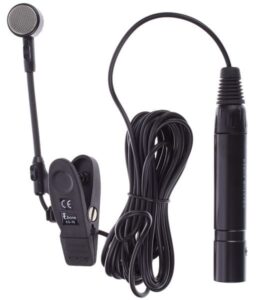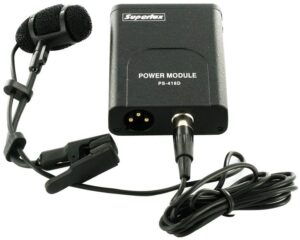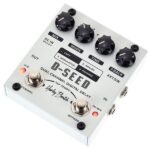So you play the violin, cool instrument, even if at the beginning of your career only your grandmother thought so. If you like folk, bluegrass, rock or even metal this instrument can fit in, and with class – BUT: What do you do when your instrument is suddenly drowned out by a twangy banjo or a inexhaustible drummer? Guitarists have definitely found a solution: electric amplification. Why can’t violinist do the same? Actually they can, read on…
The biggest hurdle for the electric amplification of the violin can be found right at the source: The vibrations of the violin need to be transformed into an electric current. For this a so-called “sound transducer” is used. This is either a microphone or a contact pickup. Which method you choose depends mainly on your desired volume. Although microphones provide a far more lifelike signal than a contact pickup, once you play louder, they quickly reach their limits and start to feedback uncontrollably.

Naturally: Violin Mics
There are different methods for mic’ing your violin, but on a stage, generally speaking, a small mic clamped to the instrument itself will work best. Every other method belongs in a controlled environment like a recording studio or classical concert. Although there are several brave bluegrass players who manage to play concerts with just a single large-diaphragm condenser mic in the middle of the stage such as the t.bone SC 1100.
Among the clip-on mics, there are a few chic and instrument-specific solutions, such as the t.bone Ovid system or, if you’re willing to spend more, the DPA d: vote Core 4099 Violin. These microphones sit on a flexible gooseneck, which can be bent in all directions. There is no standard position, because every instrument is different. As a rule of thumb, you should keep away from the F-Holes, but go ahead and experiment, it might work best for your unique instrument.
Think outside the box
You can actually achieve excellent results with clip mics that are intended for other types of instruments, for example mics for wind players. They are simply clamped to the chin-rests and then hang directly above the F-hole. This is a great, uncomplicated solution, especially when connected to a wireless system.
When you need play louder (either for dynamics or according to a composition), things can get complicated. If only you could remove the vibrations from the instrument… There are a few special solutions by Schertler, Headway or Ehrlung that are worth mentioning (see pics below), even if they can be quite expensive, they are worth a try if nothing else works. Some people wouldn’t dare use them because they often need to be glued to the instrument itself, to the delicate varnish of their precious violin! Of course, manufacturers have taken this into consideration and developed special adhesives which do not (should not) damage the instruments.
The popular Piezo Pickup
Usually, however, violinists will resort to a piezo pickup, which is attached to the bridge. This pickup can be found in practically all electro-acoustic guitars; they are reliable, low feedback and not complicated. If you’re concerned about getting the beautiful sound of your Stradivarius across with high fidelity then there’s good news for you: A piezo pickup works better the higher the instrument’s pitch is and since a violin lies, on average, one octave above the guitar, this will work wonderfully (depending on the instrument, as always).

The downside is that many of these systems work passively. Why is that bad? The magic word is “impedance“, and a piezo has too much of it. Most amplifiers can’t handle it and deliver a thin, scratchy sound. Also, with every meter of cable, treble is lost. There are certainly cases where things can go well, but most of the time you’ll be well advised to invest in a special preamplifier and place it as close to the instrument as possible. Or you can get an active system like the NanoFlex pickup from Shadow.
Let’s get loud!
When you get over this first, most difficult and annoying, hurdle the rest is child’s play. Our amplifier systems can make a violin signal loud without problems. These days you don’t need to compete with a singer, guitarist or drummer but you have to make sure that you can hear yourself well. Those who have only played in a school orchestra don’t know the frustrating experience of not being able to hear themselves during a performance. This can even happen to drummers!
If you play on a big stage with a PA you should be fine, you simply have to ask the sound engineer for a monitor speaker. For smaller gigs you’re on your own. With an acoustic amplifier you are independent and can control both sound and volume yourself. This acoustic amp doesn’t even have to be big, because the lowest string of the violin is more than an octave higher than the lowest guitar string. And it’s the low notes that “cut through” best.
With an acoustic amp like this little AER, Hughes & Kettner or Harley Benton you are on the safe side. You should only make sure you hear it, so position it aimed at your ear(s), if necessary with a tripod (which doesn’t look cool, but sounds cool). Position it so that your head is between the amp and the instrument’s pickup. This way there’s less risk of feedback.
Next level: Effects, etc.
Those were the essentials of amplifying your violin, the rest is up to you. With your amplified violin sound you can now do whatever you want, especially when it comes to effects. All kinds of pedals that you know from your fellow six-stringers can also be plugged into your rig. You also don’t have to be afraid of distortion or similar heavy sounds. Your guitarist friend(s) will be happy to help you, maybe the video below will help too:
You are currently viewing a placeholder content from YouTube. To access the actual content, click the button below. Please note that doing so will share data with third-party providers.
Some recommended effect pedals for your amplified acoustic violin:
But there is one limitation: At a certain volume every system starts to feed back uncontrollably. We wish you a feedback-free rock, folk, pop or metal performance with the most wonderful instrument that old Europe has produced!





























Comments 0
No comments yet.